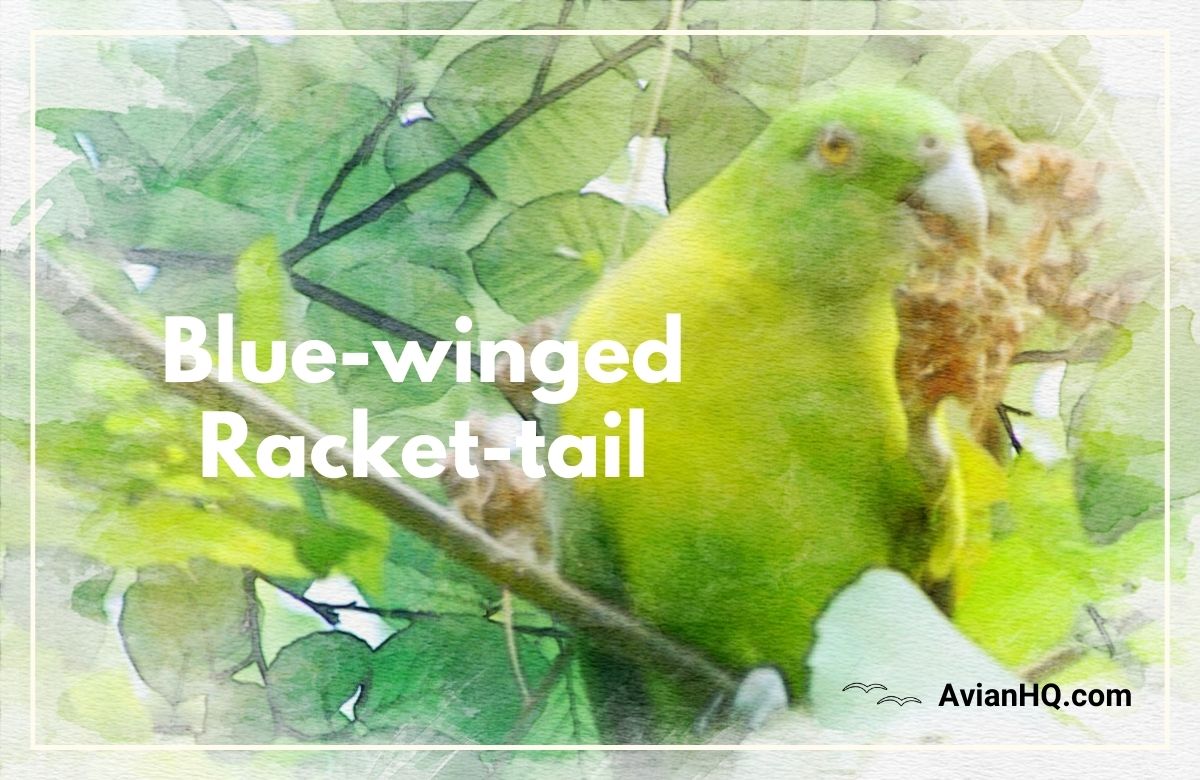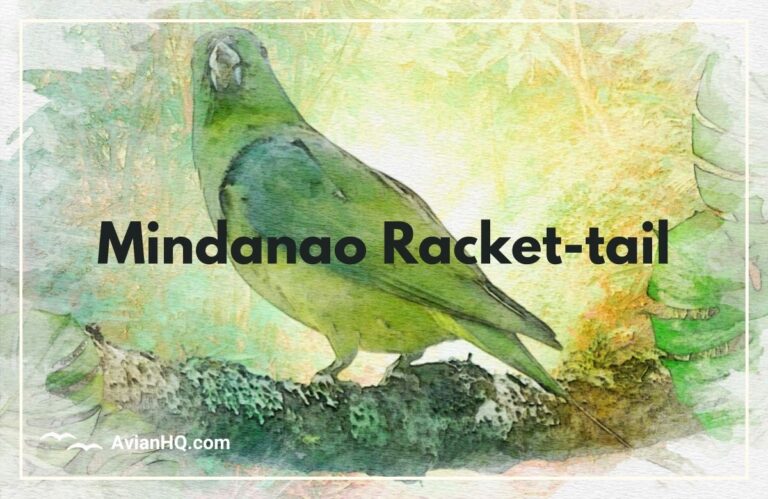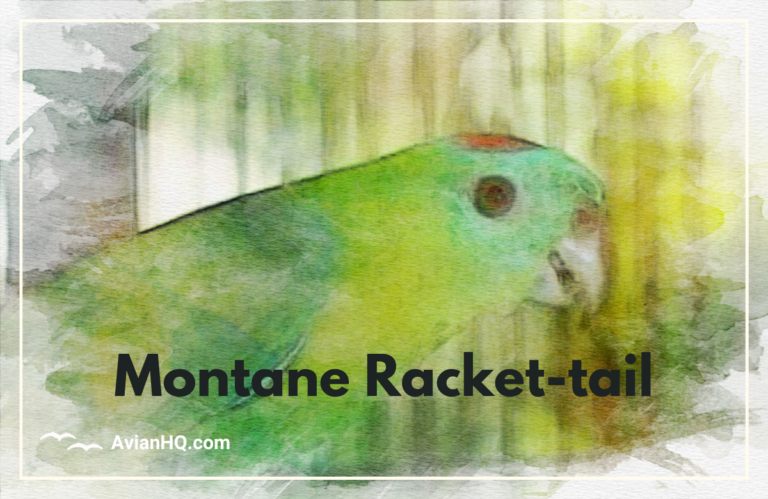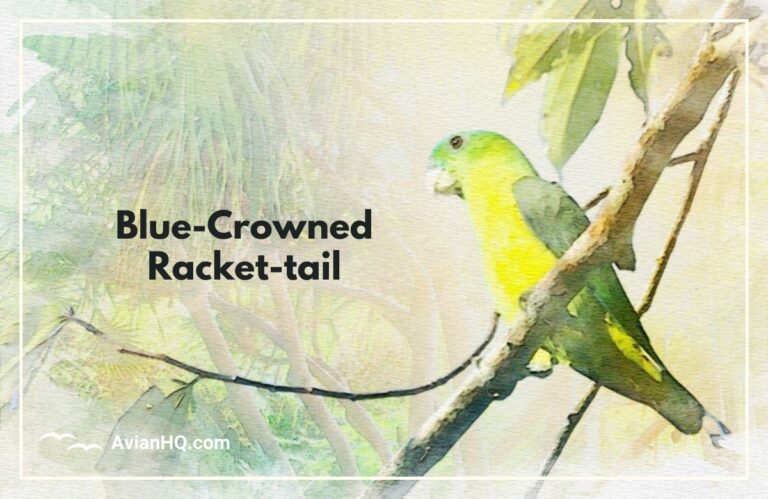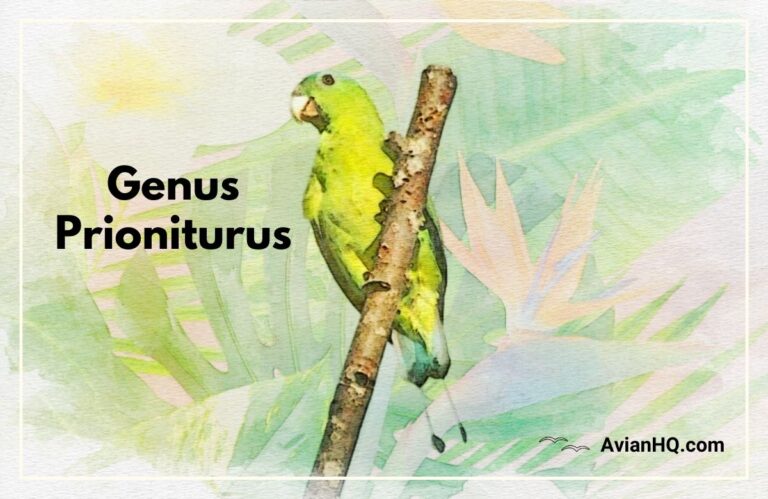Blue-winged Racket-tail Parrot (Prioniturus verticalis)
The brilliant plumage and unique racquet-shaped tail feathers of the Blue-winged Racquet-tailed Parrot make it one of the most distinctive members of the parrot family. Yet this rare beauty is on the brink of extinction.
“The Blue-winged Racquet-tail is one of the most endangered parrots in the world.”
Endemic to a few small islands in the Sulu Archipelago in the southern Philippines, these vibrant green parrots with bright blue crowns once flourished in the tropical forests. But extensive habitat destruction and poaching for the pet trade have decimated their numbers.
Today, only an estimated 50-249 mature Blue-winged Racquet-tailed Parrots remain in the wild. Classified as Critically Endangered by the IUCN Red List, the species faces imminent extinction without urgent conservation intervention.
In this article, we will explore the natural history of these remarkable parrots, threats to their survival, and efforts to bring them back from the brink.
History and Discovery
The Blue-winged Racquet-tailed Parrot was first scientifically described in 1864 by English ornithologist John Gould, based on a specimen collected from the Sulu Archipelago. He named the species Prioniturus verticalis, with the genus name meaning “saw-billed” in reference to the serrated edges of parrots’ beaks.
Historically, these brilliant green and blue parrots were relatively widespread across the islands of the Sulu Archipelago. Early accounts indicate they were numerous in the mangrove forests of Tawi-Tawi during the late 1800s and early 1900s.
Blue-winged Racquet-tails inhabit lowland rainforests, forest edges, mangroves, and remnant forest patches, mainly at elevations below 1,000 feet (305 meters). Their natural range covers approximately 1,770 square miles (4,600 km2) across the southwestern Sulu islands of Tawi-Tawi, Sibutu, Bongao, Sanga-Sanga, and several smaller islands.
However, the species has suffered a catastrophic decline over the past century due to deforestation and trapping for the pet trade. Once common on islands across the Sulu Archipelago, today Blue-winged Racquet-tails only persist in a few tiny fragmented populations on Tawi-Tawi.
Physical Appearance
The Blue-winged Racquet-tail is a medium sized parrot, measuring about 13-14 inches (35 cm) long. Their most distinctive feature is the racquet-shaped tail feathers that give the species it’s name. These elongated feathers can extend 5-6 inches (12-15 cm) beyond the tail.
These parrots have bright green plumage on the head, back, wings, and breast. The crown is a striking pale blue in males, while females have a lighter blue crown. Adult males also have a small red patch in the center of the forehead.
The rump and belly feathers are a yellowish olive-green. The wing feathers have an iridescent bluish tint on the outer webs. The racquet-shaped tail feathers are blackish in color.
The Blue-winged Racquet-tail’s bill is whitish gray. The legs are gray and the eyes are dark brown. Juveniles resemble adult females but have shorter tail feathers.
These parrots are usually seen in pairs or small flocks flying high over the rainforest canopy, their green wings flickering amid the blue tail plumes. Their noisy calls ring out overhead. When feeding quietly in treetops, they can be remarkably difficult to detect.
Habitat and Distribution
The Blue-winged Racquet-tail is endemic to the Sulu Archipelago in the southwestern Philippines. It’s natural range covers just a few small islands:
- Tawi-Tawi – The largest remaining population, though much declined from historical numbers.
- Sibutu – Very little forest remains. Population likely tiny and close to extinction.
- Bongao – Now considered probably extinct on this island.
- Sanga-Sanga – Suspected to be extinct here as almost no forest left.
- Tumindao – No recent records, likely extirpated.
These parrots inhabit tropical lowland rainforests, forest edges, mangroves, and dense remnant forest patches. They occur mainly at elevations below 1,000 feet (300 m), though have been recorded up to 3,000 feet (900 m).
Their habitat needs include large trees for nesting and roosting sites, a dense canopy for protection, and plenty of fruiting trees to provide food.
Deforestation has destroyed the vast majority of their specialized forest habitat. Remaining native forest is now limited to rugged upland areas and tiny fragmented patches on Tawi-Tawi.
Diet and Feeding
The diet of Blue-winged Racquet-tails consists mainly of fruits, seeds, and nectar from native rainforest trees.
They forage for food high in the treetops, using their curved beaks to pluck and peel fruits. Their favorites include figs, palm fruits, and other tropical fruits.
These parrots are most active in early morning, noisily flying between fruiting and flowering trees. They feed quietly once settled in the high canopy, making them difficult to detect.
Pairs or small flocks may gather at particularly abundant food sources. They occasionally descend to lower levels closer to the forest floor.
As with many parrot species, the Blue-winged Racquet-tail likely plays an important role in seed dispersal through the rainforest. Their specialized diet relies on a diversity of fruiting trees and a healthy, intact forest ecosystem.
Little is known about their specific foraging behaviors due to their remote habitat and critically low numbers. More research is needed to fully understand their ecological roles and relationships with food plants.
Breeding and Reproduction
Very little is known about the breeding habits of Blue-winged Racquet-tails since so few nests have been located. They are thought to nest in the hollows of large rainforest trees.
The only nest ever described was discovered in September 1991 on Tawi-Tawi Island. It was located in a broken-off coconut palm about 65 feet (20 meters) above the ground.
Based on observations of juvenile birds and specimens, the breeding season is believed to run from September through January. Clutch size is unknown but likely 2-4 eggs.
Incubation period and nestling time have not been recorded. For related parrot species, incubation ranges 20-30 days. Chicks usually fledge at 6-8 weeks old.
More research is critically needed on their breeding ecology, including nest sites, clutch size, incubation and rearing behaviors, and age at fledging. Such data would assist future captive breeding efforts if extinction in the wild becomes imminent.
Protecting known nesting trees and increasing availability of suitable nest cavities may help support wild breeding. Engaging local communities to report nest sightings could also expand knowledge and conservation of this critically endangered species.
Conservation Status and Threats
The Blue-winged Racquet-tail is classified as Critically Endangered by the IUCN Red List, the highest risk category before extinction.
It’s population is estimated at only 50-249 mature individuals as of 2018 surveys. This is an extremely small population for a species’ long-term survival.
These parrots face an extremely high risk of extinction in the wild within the next few years if urgent conservation action is not taken.
The major threats contributing to their endangered status include:
- Habitat Loss – Extensive deforestation has destroyed over 90% of their lowland rainforest habitat. Forest clearing for logging, agriculture, mining and settlement continues to reduce available nesting and feeding habitat.
- Poaching – Trapping for the illegal pet trade has heavily impacted their numbers. Their tameness makes them an easy target for poachers.
- Small population size – With so few individuals left, the species is at risk from inbreeding depression and reduced genetic diversity.
- Natural disasters – Small populations concentrated on just a few islands are vulnerable to severe storms, disease outbreaks, or other stochastic events.
Protecting remaining forest habitat, anti-poaching enforcement, and community engagement will be critical to saving this parrot from extinction. Captive breeding programs may serve as an insurance population if their numbers continue to decline.
Efforts to Save the Species
Several conservation actions are urgently needed to prevent extinction of the Blue-winged Racquet-tail:
- Habitat Protection – Safeguard remaining forest fragments that contain the last wild populations. Strictly protect known nesting and roosting sites.
- Anti-Poaching Measures – Increased enforcement and penalties for illegal trapping. Engage local communities against poaching.
- Population Monitoring – Regular surveys to track population trends and distribution. Targeted studies on breeding ecology.
- Community Engagement – Partner with local villages for habitat protection and sustainable development. Environmental education programs.
- Captive Breeding – Establish an ex-situ insurance population in captivity. Successful breeding and reintroduction has saved other parrot species.
- Ecotourism – Birdwatching tours focused on the Blue-winged Racquet-tail could generate income for local communities while supporting habitat conservation.
Some initial conservation steps have been taken, such as public education campaigns in the Sulu Archipelago and proposals for protected areas. However, substantial and immediate action is still required to stabilize and recover diminishing populations before the species is lost completely.
Relationships with Humans
The Blue-winged Racquet-tail has a conflicted relationship with humans. Valued for it’s beauty as a pet, it has also suffered severely from trapping and habitat destruction.
These trusting parrots are easily caught by poachers due to their tameness. Trapping for the illegal cage bird trade has contributed to their endangered status. However, it’s bright colors and unique racquet tail feathers make it a prized collector’s item.
If stabilized and protected, ecotourism focused on the Blue-winged Racquet-tail could provide economic benefits to local communities. Birdwatchers travel worldwide to see rare and endangered species. Well-managed tourism with small guided tours may offer an incentive for habitat conservation.
Outreach is also needed to instill pride and change attitudes towards protecting this endemic treasure of the Sulu Islands. If it becomes extinct in the wild, a piece of Philippine natural heritage will be lost forever.
Conclusion
The Blue-winged Racquet-tail’s extravagant tail feathers and jeweled colors make it one of the most spectacular parrots on Earth. Sadly, unchecked habitat destruction and trapping have brought this Philippine endemic to the brink of extinction.
With an estimated 50-249 individuals remaining, this distinctive parrot’s future in the wild is tenuous at best. Urgent actions – including strengthened legal protections, anti-poaching measures, habitat conservation, and community engagement – are required to pull it back from the edge.
Captive breeding may serve as a final lifeline for the brilliant Blue-winged Racquet-tail. But this rare species ideally belongs flying free over it’s native Sulu rainforests, where it’s raucous cries once commonly rang out. Concerted conservation efforts today could ensure future generations have the chance to encounter this exotic tropical beauty in it’s natural home.
The Blue-winged Racquet-tail’s fate now hangs in the balance. With intensive interventions, humans can write a happier ending to this parrot’s story – one that preserves it’s endemic wonders for all time.

